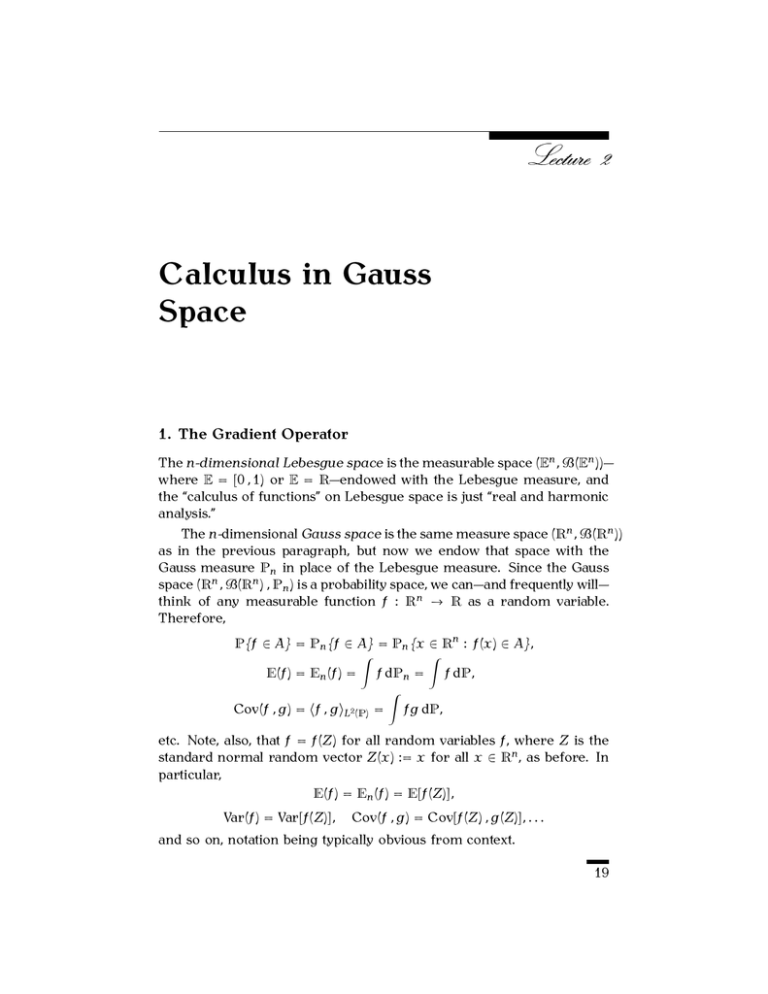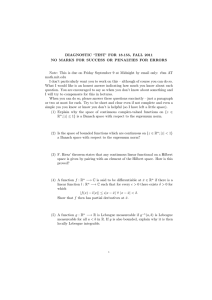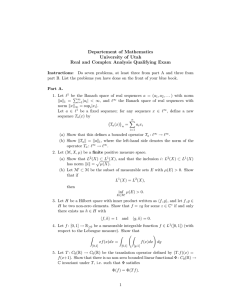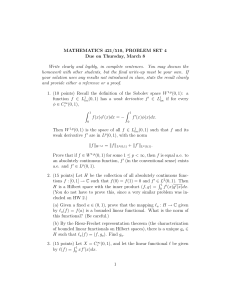Calculus in Gauss Space 1. The Gradient Operator
advertisement

Calculus in Gauss
Space
1. The Gradient Operator
The �-dimensional Lebesgue space is the measurable space (E� � �(E� ))—
where E = [0 � 1) or E = R—endowed with the Lebesgue measure, and
the “calculus of functions” on Lebesgue space is just “real and harmonic
analysis.”
The �-dimensional Gauss space is the same measure space (R� � �(R� ))
as in the previous paragraph, but now we endow that space with the
Gauss measure P� in place of the Lebesgue measure. Since the Gauss
space (R� � �(R� ) � P� ) is a probability space, we can—and frequently will—
think of any measurable function � : R� → R as a random variable.
Therefore,
P{� ∈ A} = P� {� ∈ A} = P� {� ∈ R� : �(�) ∈ A}�
�
�
E(�) = E� (�) = � dP� = � dP�
�
Cov(� � �) = �� � ��L2 (P) = �� dP�
etc. Note, also, that � = �(Z) for all random variables �, where Z is the
standard normal random vector Z(�) := � for all � ∈ R� , as before. In
particular,
E(�) = E� (�) = E[�(Z)]�
Var(�) = Var[�(Z)]�
Cov(� � �) = Cov[�(Z) � �(Z)]� � � �
and so on, notation being typically obvious from context.
19
20
2. Calculus in Gauss Space
Let ∂� := ∂/∂�� for all 1 6 � 6 � and let ∇ := (∂1 � � � � � ∂� ) denote
the gradient operator, acting on continuously-differentiable functions � :
R� → R. From now on we will use the following.
Definition 1.1. Let C0� (P� ) denote the collection of all infinitely-differentiable
functions � : R� → R such that � and all of its mixed derivatives of order 6 � grow more slowly than [γ� (�)]−ε for every ε > 0. Equivalently,
� ∈ C0� (P� ) if and only if
2
2
lim e−ε��� |�(�)| = lim e−ε��� |(∂�1 · · · ∂�� �)(�)| = 0�
���→∞
���→∞
for all 1 6 �1 � � � � � �� 6 � and 1 6 � 6 �. We also define
C0∞ (P� ) :=
∞
�
�=1
C0� (P� )�
We will frequently use the following without mention.
Lemma 1.2. If � ∈ C0� (P� ), then
E (|�|� ) < ∞ and
E (|∂�1 · · · ∂�� �|� ) < ∞�
for all 1 6 � < ∞, 1 6 �1 � � � � � �� 6 �, and 1 6 � 6 �.
I omit the proof since it is elementary.
For every � ∈ C01 (P� ), define
�
�
2
2
���1�2 :=
|�(�)| P� (d�) + �(∇�)(�)�2 P� (d�)
� �
�
�
= E |�|2 + E �∇��2 �
Notice that � · �1�2 is a bona fide Hilbertian norm on C02 (P� ) with Hilbertian inner product
�
�
�� � ��1�2 :=
�� dP� + (∇�) · (∇�) dP�
= E[��] + E[∇� · ∇�]�
We will soon see that C02 (P� ) is not a Hilbert space with the preceding
norm and inner product because it is not complete. This observation
prompts the following definition.
Definition 1.3. The Gaussian Sobolev space D1�2 (P� ) is the completion
of C01 (P� ) in the norm � · �1�2 .
In order to understand what the elements of D1�2 (P� ) look like consider a function � ∈ D1�2 (P� ). By definition we can find a sequence
1. The Gradient Operator
21
�1 � �2 � � � � ∈ C01 (P� ) such that ��� − ��1�2 → 0 as � → ∞. Since L2 (P� ) is
complete, we can deduce also that
D� � := lim ∂� ��
�→∞
exists in L2 (P� ) for every 1 6 � 6 �.
It follows, by virtue of construction, that
D� = ∇�
for all � ∈ C01 (P� ).
Therefore, D is an extension of the gradient operator from C01 (P� ) to
D1�2 (P� ). From now on, I will almost always write D� in favor of ∇�
when � ∈ C01 (P� ). This is because D� can make sense even when � is
not in C01 (P� ), as we will see in the next few examples.
In general, we can think of elements of D1�2 (P� ) as functions in L2 (P� )
that have one weak derivative in L2 (P� ). We may refer to the linear
operator D as the Malliavin derivative, and the random variable D� as
the [generalized] gradient of �. We will formalize this notation further
at the end of this section. For now, let us note instead that the standard
Sobolev space W 1�2 (R� ) is obtained in exactly the same way as D1�2 (P� )
was, but the Lebesgue measure is used in place of P� everywhere. Since
γ� (�) = dP� (�)/d� < 1,1 it follows that the Hilbert space D1�2 (P� ) is richer
than the Hilbert space W 1�2 (R� ), whence the Malliavin derivative is an
extension of Sobolev’s [generalized] gradient.2
ex:Smoothing:1
It is a natural time to produce examples to show that the space
1
� ) is strictly larger than the space C0 (P� ) endowed with the norm
� · �1�2 .
D1�2 (P
Example 1.4 (� = 1). Consider the case � = 1 and let
�(�) := (1 − |�|)+
D1�2 (P
for all � ∈ R�
C01 (P1 )
Then we claim that � ∈
and in fact we have the P1 -a.s.
1) \
3
identity,
(D�)(�) = −sign(�)1[−1�1] (�)�
whose intuitive meaning ought to be clear.
In order to prove these assertions let ψ1 be a symmetric probability
density function on R such that ψ1 ∈ C ∞ (R), ψ1 ≡ a positive constant on
[−1 � 1], and ψ1 ≡ 0 off of [−2 � 2]. For every real number � > 0, define
ψ� (�) := �ψ1 (��) and �� (�) := (� ∗ ψ� )(�). Then sup� |�N (�) − �(�)| → 0 as
1In other words, E(|�|2 ) < � |�(�)|2 d� for all � ∈ L2 (R� ) that are strictly positive on a set of
R�
positive Lebesgue measure.
2The extension is strict. For instance, �(�) := exp(�) [� ∈ R] defines a function in D1�2 (P )\W 1�2 (R).
1
3It might help to recall that D� is defined as an element of the Hilbert space L2 (P ) in this case.
1
Therefore, it does not make sense to try to compute (D�)(�) for all � ∈ R. This issue arises when
one constructs any random variable on any probability space, of course. Also, note that P1 -a.s.
equality is the same thing as Lebesgue-a.e. equality.
22
2. Calculus in Gauss Space
N → ∞ because � is uniformly continuous. In particular, ��N − ��L2 (P� ) →
0 as N → ∞. To complete the proof it remains to verify that
�
lim
|�N� (�) + sign(�)1[−1�1] (�)|2 P� (d�) = 0�
(2.1)
N→∞
By the dominated convergence theorem and integration by parts,
� ∞
� 1
� 0
�
�
�N (�) =
�(�)ψN (� − �) d� =
ψN (� − �) d� +
ψN (� − �) d�
−∞
0
:= − AN (�) + BN (�)�
−1
I will prove that AN → 1[0�∞) as N → ∞ in L2 (P1 ); a small adaptation of
this argument will also prove that BN → 1(−∞�0] in L2 (P1 ), from which
(2.1) ensues.
ex:Smoothing:2
We can apply a change of variables, together with the symmetry of
� N(1−�)
ψ1 , in order to see that AN (�) = −N� ψ1 (�) d�� Therefore, AN (�) →
−sign(�)1[0�∞) (�) as N → ∞ for all � �= 0. Since AN (�) + sign(�)1[0�∞) (�)
is bounded uniformly by 2, the dominated convergence theorem implies
that AN (�) → −sign(�)1[−1�1] (�) as N → ∞ in L2 (P1 ). This concludes our
example.
Example 1.5 (� > 2). Let us consider the case that � > 2. In order to
produce a function F ∈ D1�2 (P� ) \ C01 (P� ) we use the construction of the
previous example and set
�
�
�
�
F(�) :=
�(�� ) and ΨN (�) :=
ψN (�� ) for all � ∈ R� and N > 1�
�=1
�=1
Then the calculations of Example 1.4 also imply that FN := F ∗ΨN → F as
N → ∞ in the norm � · · · �1�2 of D1�2 (P� ), FN ∈ C01 (P� ), and F �∈ C01 (P� ).
Thus, it follows that F ∈ D1�2 (P� ) \ C01 (P� ). Furthermore,
�
(D� F)(�) = −sign(�� )1[−1�1] (�� ) ×
�(�� )�
16�6�
��=�
ex:Lipschitz:D12
for every 1 6 � 6 � and P� -almost every � ∈ R� .
Example 1.6. The previous two examples are particular cases of a more
general family of examples. Recall that a function � : R� → R is Lipschitz
continuous if there exists a finite constant K such that |�(�) − �(�)| 6
K�� − �� for all �� � ∈ R� . The smallest such constant K is called the
Lipschitz constant of � and is denoted by Lip(�). Let � : R� → R be a
Lipschitz function. According to Rademacher’s theorem XXX, � is almost
everywhere [equivalently, P� -a.s.] differentiable and �(∇�)(�)� 6 Lip(�)
a.s. Also note that
|�(�)| 6 |�(0)| + Lip(�)���
for all � ∈ R� .
goal:n=1
1. The Gradient Operator
23
In particular, E(|�|� ) < ∞ for all � > 1. A density argument, similar to
the one that appeared in the preceding examples, shows that � ∈ D1�2 (P� )
and
�D�� 6 Lip(�)
a.s.
We will appeal to this fact several times in this course.
lem:ChainRule
The generalized gradient D follows more or less the same general
set of rules as does the more usual gradient operator ∇. And it frequently behaves as one expect it should even when it is understood as
the Gaussian extension of ∇; see Examples (1.4) and (1.5) to wit. The
following ought to reinforce this point of view.
Lemma 1.7 (Chain Rule). For all ψ ∈ D1�2 (P1 ) and � ∈ D1�2 (P� ),
D(ψ ◦ �) = [(Dψ) ◦ �] D(�)
a.s.
Proof. If � and ψ are continuously differentiable then the chain rule of
calculus ensures that [∂� (ψ ◦ �)](�) = ψ� (�(�))(∂� �)(�) for all � ∈ R� and
1 6 � 6 �. That is,
D(� ◦ �) = ∇(ψ ◦ �) = (ψ� ◦ �)(∇�) = (Dψ)(�)D(�)�
where Dψ refers to the one-dimensional Malliavin derivative of ψ and
D(�) := D� refers to the �-dimensional Malliavin derivative of �. In
general we appeal to a density argument.
⇤
ex:DM
Here is a final example that is worthy of mention.
Example 1.8. Let M := max16�6� Z� and note that
M(�) = max �� =
16�6�
�
�
�=1
�� 1Q(�) (�)
for P� -almost all � ∈ R� �
where Q(�) denotes the cone of all points � ∈ R� such that �� > max��=� �� .
We can approximate the indicator function of Q(�) by a smooth function
to see that M ∈ D1�2 (P� ) and D� M = 1Q(�) a.s. for all 1 6 � 6 �. Let
J(�) := arg max(�)�
Clearly, J is defined uniquely for P� -almost every � ∈ R� . And our
computation of D� M is equivalent to
(DM)(�) = J(�)
for P� -almost all � ∈ R� �
where 1 � � � � � � denote the standard basis of R� .
24
2. Calculus in Gauss Space
Let us end this section by introducing a little more notation.
The preceding discussion constructs, for every function � ∈ D1�2 (P� ),
the Malliavin derivative D� as an R� -valued function with coordinates in
L2 (P� ). We will use the following natural notations exchangeably:
(D�)(� � �) := [(D�)(�)]� = (D� �)(�)�
for every � ∈ D1�2 (P� ), � ∈ R� , and 1 6 � 6 �� In this way we may
also think of D� as a scalar-valued element of the real Hilbert space
L2 (P� × χ� ), where
Definition 1.9. χ� always denotes the counting measure on {1 � � � � � �}.
We see also that the inner product on D1�2 (P� ) is
�� � ��1�2 = �� � ��L2 (P� ) + �D� � D��L2 (P� ×χ� )
= E(��) + E (D� · D�)
for all �� � ∈ D1�2 (P� )�
Definition 1.10. The random variable D� ∈ L2 (P� × χ� ) is called the
Malliavin derivative of the random variable � ∈ D1�2 (P� ).
2. Higher-Order Derivatives
One can define higher-order weak derivatives just as easily as we obtained the directional weak derivatives.
Choose and fix � ∈ C 2 (R� ) and two integers 1 6 �� � 6 �. The mixed
derivative of � in direction (� � �) is the function � �� (∂2��� �)(�), where
∂2��� � := ∂� ∂� � = ∂� ∂� ��
The Hessian operator ∇2 is defined as
⎛
∂21�1
⎜
∇2 := ⎝ ...
∂2��1
···
..
.
···
⎞
∂21��
.. ⎟ �
. ⎠
∂2���
2. Higher-Order Derivatives
25
With this in mind, we can define a Hilbertian inner product � · � ·�2�2 via
�
�
�
�
�
�� � ��2�2 :=
�� dP� + (∇�) · (∇�) P� (d�) + tr (∇2 �)(∇2 �) dP�
=
�
�(�)�(�) P� (d�) +
�
� �
�
�=1
+
(∂� �)(�)(∂� �)(�) P� (d�)
� �
�
���=1
(∂2��� �)(�)(∂2��� �)(�) P� (d�)
(∇2 �) · (∇2 �) dP�
�
�
= E(��) + E [∇� · ∇�] + E ∇2 � · ∇2 �
= �� � ��1�2 +
[�� � ∈ C02 (P� )]�
where K · M denotes the matrix—or Hilbert–Schmidt—inner product,
K · M :=
�
�
���=1
for all � × � matrices K and M.
K��� M��� = tr(K� M)�
We also obtain the corresponding Hilbertian norm � · �2�2 where:
���22�2
=
���2L2 (P� )
+
�
�
�=1
�∂� ��2L2 (P� )
� �
�
�
� 2 �2
+
�∂��� � � 2
���=1
�
�2
�
�
= ���21�2 + �∇2 � � 2
L (P� ×χ�2 )
� �
�
�
�
�
= E � 2 + E �∇��2 + E �∇2 ��2
L (P� )
[� ∈ C02 (P� )];
χ�2 := χ� × χ� denotes the counting measure on {1 � · · · � �}2 ; and
�
��
�
√
� �
2
�K� := K · K = �
K���
= tr(K� K)
���=1
denotes the Hilbert–Schmidt norm of any � × � matrix K.
Definition 2.1. The Gaussian Sobolev space D2�2 (P� ) is the completion
of C02 (P� ) in the norm � · �2�2 .
For every � ∈ D2�2 (P� ) we can find functions �1 � �2 � � � � ∈ C02 (P� ) such
2
that ��� − ��2�2 → 0 as � → ∞ Then D� � and D���
� := lim�→∞ ∂2��� � exist
in L2 (P� ) for every 1 6 �� � 6 �. Equivalently, D� = lim�→∞ ∇� exists in
L2 (P� × χ� ) and D2 � = lim�→∞ ∇2 � exists in L2 (P� × χ�2 ).
26
2. Calculus in Gauss Space
Choose and fix an integer � > 2. If � = (�1 � � � � � �� ) is a vector of �
integers in {1 � � � � � �}, then write
(∂�� �)(�) := (∂�1 · · · ∂�� �)(�)
[� ∈ C � (R� )� � ∈ R� ]�
Let ∇� denote the formal �-tensor whose �-th coordinate is ∂�� .
We define a Hilbertian inner product � · � ·���2 [inductively] via
�
�� � ����2 = �� � ���−1�2 + (∇� �) · (∇� �) dP� �
for all �� � ∈ C0� (P� ), where “·” denotes the Hilbert–Schmidtt inner product for �-tensors:
�
K · M :=
K� M � �
�∈{1 ������}�
for all �-tensors K and M. The corresponding norm is defined via
�����2 := �� � ��1/2
2�2 .
Definition 2.2. The Gaussian Sobolev space D��2 (P� ) is the completion
of C0� (P� ) in the norm � · ���2 . We also define D∞�2 (P� ) := ∪�>1 D��2 (P� ).
If � ∈ D��2 (P� ) then we can find a sequence of functions �1 � �2 � � � � ∈
C0� (P� ) such that ��� − ����2 → 0 as � → ∞. It then follows that
D� � := lim ∇� ��
�→∞
�
exists in L2 (P� × χ�� )�
for every 1 6 � 6 �, where χ� := χ� × · · · × χ� [� − 1 times] denotes
the counting measure on {1 � � � � � �}� . The operator D� is called the �th
Malliavin derivative.
It is easy to see that the Gaussian Sobolev spaces are nested; that is,
D��2 (P� ) ⊂ D�−1�2 (P� )
for all 2 6 � 6 ∞�
Also, whenever � ∈ C0� (P� ), the �th Malliavin derivative of � is just the
classically-defined derivative ∇� �, which is a �-dimensional tensor. Because every polynomial in � variables is in C0∞ (P� ),4 it follows immediately that D∞�2 (R� ) contains all �-variable polynomials; and that all
Malliavin derivatives acts as one might expect them to.
More generally, we have the following.
4A function � : R� → R is a polynomial in � variables if it can be written as �(�) = � (� )×· · ·×� (� ),
1 1
� �
for all � = (�1 � � � � � �� ) ∈ R� , where each �� is a polynomial on R. The degree of the polynomial �
is the maximum of the degrees of �1 � � � � � �� . Thus, for example �(�) = �1 �23 − 2�5 is a polynomial
of degree 3 in 5 variables.
3. The Adjoint Operator
def:D:k,p
27
Definition 2.3. We define Gaussian Sobolev spaces D��� (P� ) by completing the space C0∞ (P� ) in the norm
⎡
⎤1/�
�
�
�
�
⎦ �
���D��� (P� ) := ⎣���L� (P� ) +
�D� �� �
�
�=1
L (P� ×χ� )
Each D��� (P� ) is a Banach space in the preceding norm.
3. The Adjoint Operator
Recall the canonical Gaussian probability density function γ� := dP� /d�
from (1.1). Since (D� γ� )(�) = −�� γ� (�), we can apply the chain rule to
see that for every �� � ∈ C01 (P� ),
�
�
(D� �)(�)�(�) P� (d�) = −
�(�)D� [�(�)γ� (�)] d�
R�
R�
�
�
=−
�(�)(D� �)(�) P� (d�) +
�(�)�(�)�� P� (d�)�
R�
R�
for 1 6 � 6 �. Let � := (�1 � � � � � �� ) and sum the preceding over all
1 6 � 6 � to find the following “adjoint relation,”
�
�
�
�
E D� (�)� = �D� � � ��L2 (P� ) = �� � A� ��L2 (P� ) = E �A� (�) �
(2.2)
where A is the formal adjoint of D; that is,
(A�)(�) := −(D�)(�) + ��(�)�
(2.3)
Eq. (2.3) is defined pointwise whenever � ∈ C01 (P� ). But it also makes
sense as an identity in L2 (P� × χ� ) if, for example, � ∈ D1�2 (P� ) and
� �� ��(�) is in L2 (P� × χ� ).
Let us pause to emphasize that (2.2) can be stated equivalently as
as �-vectors.5
E[�D(�)] = E[�A(�)]�
(2.4)
If � ∈ D1�2 (P� ), then we can always find �1 � �2 � � � � ∈ C01 (P� ) such that
��� − ��1�2 → 0 as � → ∞. Note that
��
�
�
�
�
� �D�� dP� − � · D� dP� � 6 ���L2 (P ×χ ) �D�� − D��L2 (P ×χ )
�
�
�
�
�
�
(2.5)
6 ���L2 (P� ×χ� ) ��� − ��2�1 → 0�
5If W = (W � � � � � W ) is a random �-vector then E(W ) is the �-vector whose �th coordinate is
1
�
E(W� ).
IbP
A:g
D:delta
DfDf
28
2. Calculus in Gauss Space
as � → ∞. Also,
��
�
�
�
�
� �� A� dP� − �A� dP� � 6 �A��L2 (P ) ��� − ��L2 (P )
�
�
�
�
6 �A��L2 (P� ) ��� − ��1�2 → 0�
(2.6)
fDgfDg
(2.7)
Dom:A
whenever � ∈ C01 (P� ). We can therefore combine (2.4), (2.5), and (2.6) in
order to see that (2.4) in fact holds for all � ∈ D1�2 (P� ) and � ∈ C01 (P� ).
Finally define
�
�
Dom[A] := � ∈ D1�2 (P� ) : A� ∈ L2 (P� × χ� ) �
pr:adjoint
Since C01 (P� ) is dense in L2 (P� ) , we may infer from (2.4) and another
density argument the following.
Proposition 3.1. The adjoint relation (2.4) is valid for all � ∈ D1�2 (P� )
and � ∈ Dom[A].
Definition 3.2. The linear operator A is the adjoint operator, and Dom[A]
is called the domain of the definition—or just domain—of A.
pr:Subspace
The linear space Dom[A] has a number of nicely-behaved subspaces.
The following records an example of such a subspace.
Proposition 3.3. For every 2 < � 6 ∞,
D1�2 (P� ) ∩ L� (P� ) ⊂ Dom[A]�
Proof. We apply Hölder’s inequality to see that
�
� �
2
2
E �Z� [�(Z)] = ���2 [�(�)]2 P� (d�) 6 �� ���L� (P� ) �
where
�(�−1)/(2�)
� �
��(�−1)/(2�) ��
2�/(�−1)
2�/(�−1)
�� = E �Z�
=
���
P� (d�)
< ∞�
Therefore, Z�(Z) ∈ L2 (P� × χ� ), and we may apply (2.3) to find that
�A��L2 (P� ×χ� ) 6 �D��L2 (P� ×χ� ) + �� ���L� (P� ) 6 ���1�2 + �� ���L2 (P� ) < ∞�
This proves that � ∈ Dom[A]�
⇤
Very often, people prefer to use the divergence operator δ associated
to A in place of A itself. That is, if G = (�1 � � � � � �� ) with every �� in the
“domain of A� ,” then
(δG)(�) := (A · G)(�) :=
�
�
�=1
(A� �� )(�)�
3. The Adjoint Operator
If every �� is in C01 (P� ), then (2.3) shows that
(δG)(�) = −
�
�
�=1
(D� �� )(�) +
�
�
�=1
29
�� �� (�) = −(div �)(�) + � · �(�)�
where “div” denotes the usual divergence operator in Lebesgue space.
We will be working directly with the adjoint in these notes, and will
keep the discussion limited to A, rather than δ. Still, it is worth mentioning the scalar identity,
E [G · (D�)] = E [δ(G)�]
for all functions G : R� → R� for which δG can be defined in L2 (P� ) and
all � ∈ D1�2 (P� ). The preceding formula is aptly known as the integration
by parts formula of Malliavin calculus, and is equivalent to the statement
that A and D are L2 (P� )-adjoints of one another, though one has to pay
attention to the domains of the definition of A, D, and δ carefully in order
to make precise this equivalence.



